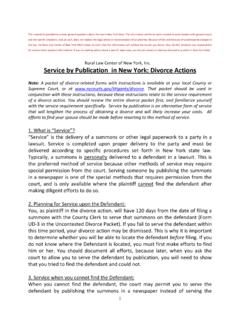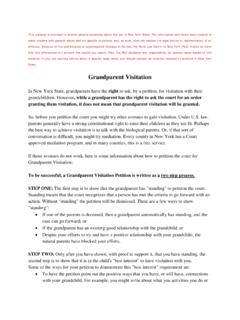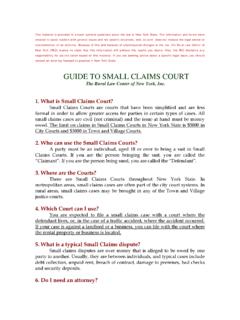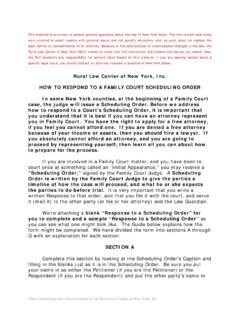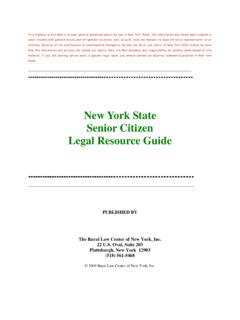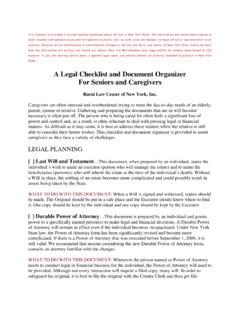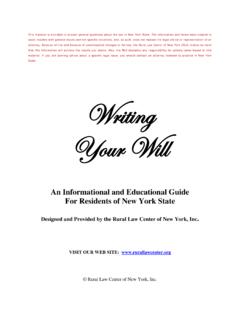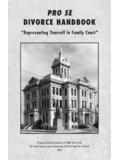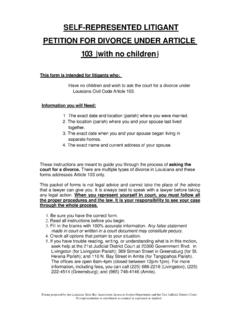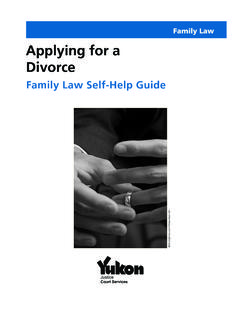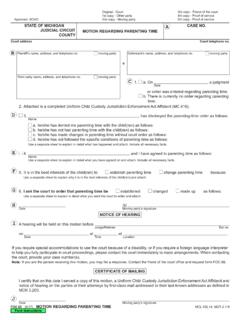Transcription of SELF -REPRESENTED UNCONTESTED DIVORCE IN …
1 This material is provided to answer general questions about the law in New York State. The information and forms were created to assist readers with general issues and not specific situations, and, as such, does not replace the legal advice or representation of an attorney. Because of this and because of unanticipated changes in the law, the Rural Law Center of New York (RLC) makes no claim that this information will achieve the results you desire. Also, the RLC disclaims any responsibility for actions taken based on this material. If you are seeking advice about a specific legal issue, you should contact an attorney licensed to practice in New York State. self -REPRESENTED UNCONTESTED DIVORCE IN NEW YORK STATE Rural Law Center of New York, Inc. This guide is presented in two parts: 1) The first set of questions and answers provides background information on self -REPRESENTED DIVORCE in New York State.
2 2) The second set of questions and answers should help you get started if you decide to proceed as a pro se or self -REPRESENTED litigant. BACKGROUND INFORMATION 1. What ar e the fir st steps to r epr esenting myself in a Divor ce in New York State? If you are seeking a self -REPRESENTED DIVORCE in New York State, you need to know that the court will need to evaluate your case based on several key areas. They include: 1) Grounds 2) Equitable Distribution of Property 3) Child Custody 4) Child Support In addition, you will have to be prepared to provide the court with detailed information about: 1) Your status as a New York State resident 2) Your current address and social security number 3) Your spouse s current address and social security number 4) If you have children, information about health insurance. 2. What is the difference between the Plaintiff and the Defendant?
3 In a DIVORCE action, the two parties are referred to as the Plaintiff and the Defendant. Even though both parties might want the DIVORCE , one of them has to initiate the action by filing the papers that begin the legal process. That person is called the Plaintiff. The Plaintiff is responsible for preparing the DIVORCE papers, paying the filing fees and arranging for service of papers on the spouse. The spouse who receives the papers is called the Defendant. 3. What are Grounds ? In New York State, Grounds for DIVORCE is the term that is used in Matrimonial Law to specify the court-accepted reasons to grant a DIVORCE . You must sufficiently meet the requirements for one of the acceptable reasons. 4. What are the different types of Grounds ? In New York State, the acceptable Grounds for DIVORCE are: 1) Abandonment 2) Cruel and Inhuman Treatment 3) Adultery 4) Confinement to Prison 5) Living apart pursuant to a Separation Judgment or Decree 6) Living pursuant to a Separation Agreement for one year 7) Irretrievable Breakdown of the Relationship (no-fault) What is important to understand is that in order to qualify for any one of these, your circumstances must meet specific requirements.
4 5. Which type of Grounds can I choose? The following is a list of each type of Grounds and a description of how each must be used. Read them over carefully to make sure your situation meets the requirements. Acceptable grounds are required. Simply not wanting to be married any longer is not sufficient. ABANDONMENT The ground of Abandonment requires that one spouse leaves the other with no intent to return. This must be without the consent of the other spouse and without justification. Additionally, this must have occurred at least one year prior to the filing of the DIVORCE . NOTE: There is an additional term called constructive abandonment . This can be one spouse s refusal to have sexual relations without both spouses agreeing. It can also be appropriate if one spouse is forced to leave because of the other s abusive behavior.
5 In either case, this choice of Ground, will require fuller documentation in your papers. CRUEL AND INHUMAN TREATMENT If you are alleging Cruel and Inhuman Treatment as Grounds, you must be able to prove a pattern of behavior that endangers your well-being and makes it unsafe or unhealthy for you to continue living with your spouse. You will need to be able to provide substantial evidence of cruel and inhuman treatment. You can do this by fully describing your spouse s continued behavior toward you. Be sure to include dates or time periods when describing incidents. Finally, and this is very important, the actions of your spouse must have occurred within 5 years of your filing for DIVORCE . If more than five years have past, you cannot use Cruel and Inhuman Treatment as Grounds. ADULTERY Under the law, adultery is defined as the commission of a voluntary act of sexual intercourse with someone other that one s spouse.
6 However, as Grounds for DIVORCE in New York State, it requires very substantial proof, such as witnesses, photographs, etc. CONFINEMENT TO PRISON If your spouse is currently in prison and has been serving a term for at least 3 years, you may use that fact alone as Grounds for DIVORCE . Your spouse must still be incarcerated at the time of the filing of the DIVORCE . LIVING PURSUANT TO A SEPARATION AGREEMENT FOR ONE YEAR In the absence of any of the above Grounds, or where both parties wish to enter the process without either being at fault, it is possible for them to enter into a Separation Agreement that sets forth their intent on all issues that need to be addressed. Once this is written, it is then signed, notarized and then generally filed with the County Clerk. If the couple continue to live separate and apart for at least one year, they may then use that Separation Agreement and its terms to file for DIVORCE .
7 IRRETRIEVABLE BREAKDOWN OF THE RELATIONSHIP (known as a No-Fault DIVORCE ). In order to use this as your Grounds, you must meet two requirements. They are: 1) One of the parties must swear under oath that the relationship has broken down irretrievably for a period of over six months. 2) Both you and your spouse must have resolved all issues of equitable distribution, spousal support, child support, counsel and expert fees (if applicable), and custody and visitation. 6. What is Equitable Distribution? Equitable Distribution is the term used to describe the required division of the property belonging to a married couple and acquired by either or both spouses during the marriage. New York State law requires that this property be distributed equally or fairly between both parties. If you and your spouse have not agreed to the distribution of marital property, the court, after a thorough hearing, will decide what is a fair division of your property.
8 There are many things that the court will take into consideration in making this decision. Some of those include: the length of the marriage, each spouse s financial situation and financial contributions, and the assets, such as real estate, bank accounts and pensions. In addition to marital property, marital debt is also considered in assessing equitable distribution. It is important to note here that merely dividing your debts does not end your responsibility for those debts to your creditors. If there is significant marital property, such as real estate or pensions, to be considered, it is very important that you consult a lawyer. The evaluation of these types of assets is a complicated process and often requires the work of experts in order to secure your rights and minimize the risks. 7. What if I own property separately?
9 There are some types of property that are considered separate and not subject to equitable distribution. This includes assets owned before the marriage or inherited, as long as this property is kept separate during the marriage. This also includes assets that are the result of compensation for personal injury. Generally, however, property acquired during the marriage but held only in one spouse s name is still considered marital property and not exempt from equitable distribution. 8. What is Spousal Support? Spousal Support or Maintenance are the terms for what used to be called alimony , and is an amount of money paid by one spouse to the other as a condition of the DIVORCE . This amount may be either agreed upon or awarded by the court. 9. How is the Custody of children determined in a DIVORCE ? If the couple has children together and any of those children are under 21 years of age, the issue of custody must be established to the satisfaction of the court.
10 There are many factors that the court must consider in making this determination and they all center on what is called the best interests of the child . When determining that, the court looks at a wide range of factors, including the child s age, the home environment, the relationship with the parent, and the potential for safety and security. Based on those factors, the court will consider the type of custody and visitation arrangement most suitable for the situation. 10. Can we decide on our own what we want as a custody ar r angement? When you are both in agreement about the terms of custody and the scheduling of custodial periods, it is possible for you to enter into a formal written agreement stating your wishes. Be aware, though, that the court will look carefully at your agreement to make sure it meets the factors described above.

